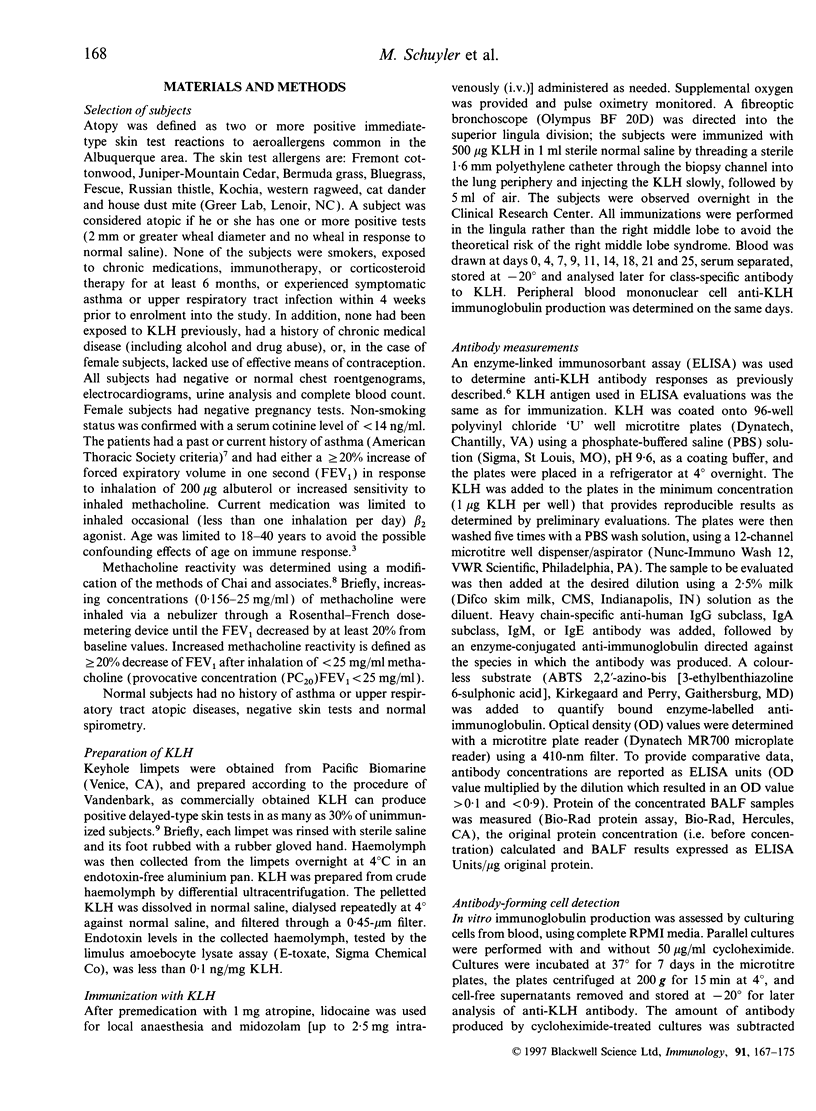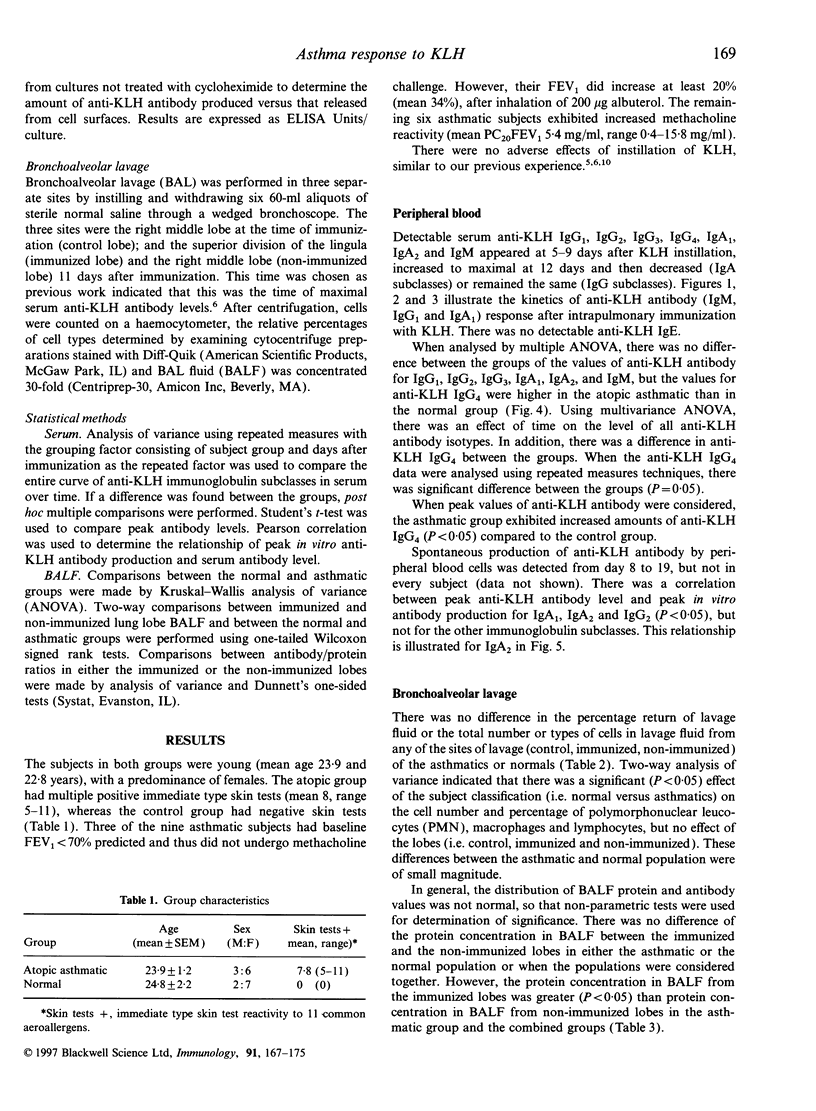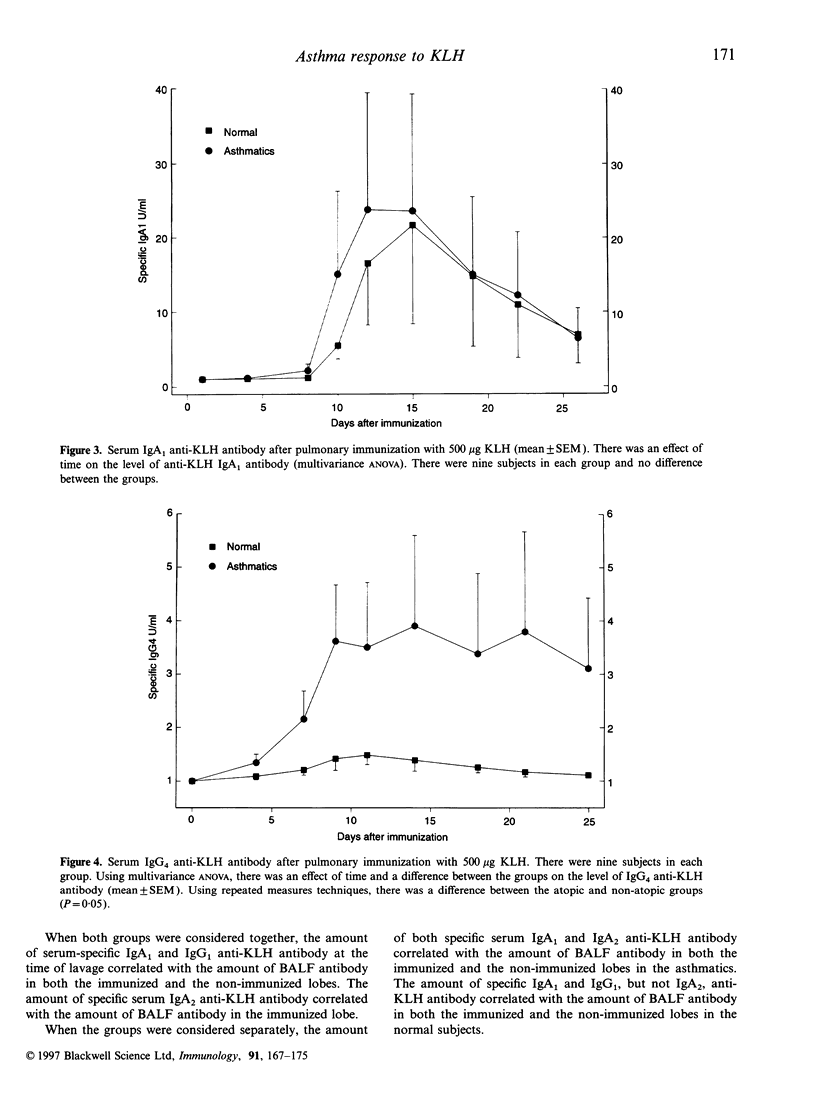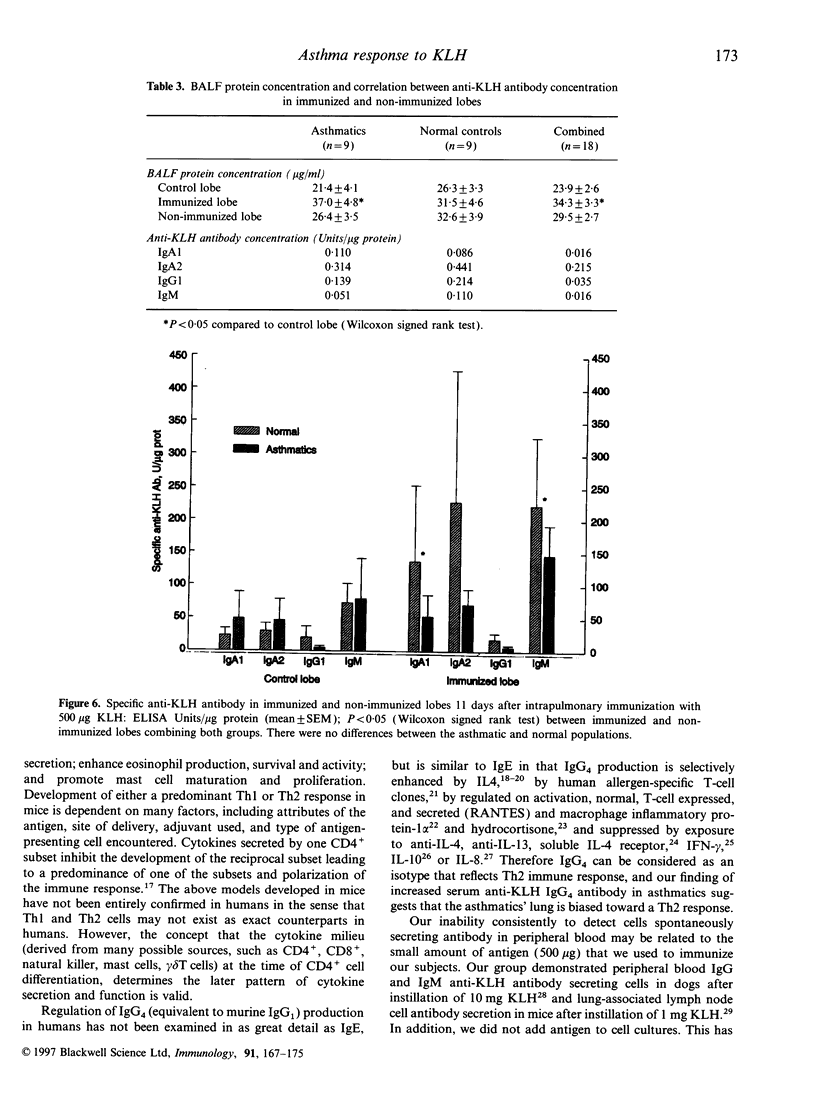Abstract
Atopic asthmatics, compared to non-atopic individuals, exhibit an increased amount of serum antigen-specific IgE and IgG4 antibody directed toward many aeroallergens. We tested the hypothesis that this difference between atopics and non-atopics extends to the response to intrapulmonary deposition of a neoantigen, keyhole limpets haemocyanin (KLH). We immunized nine atopic asthmatics and nine non-atopic controls with 500 micrograms KLH instilled into a subsegment of the lingula and examined serum anti-KLH, IgG1, IgG2, IgG3, IgG4, IgA1, IgA2, and IgM and specific antibody production by peripheral blood mononuclear cells for 25 days. We also determined specific antibody in bronchoalveolar lavage fluid (BALF) in both the immunized and a non-immunized lobe 11 days after immunization. We found specific serum antibody in all immunized subjects with no difference between atopics and normals in the amount or kinetics of anti-KLH IgG1, IgG2, IgG3, IgA1, IgA2 and IgM. However, the atopics exhibited more anti-KLH IgG4 than the normal controls. Specific anti-KLH antibody-producing cells were detected in peripheral blood in most subjects at day 8 to 12 after immunization with no difference between atopics and normals. Specific IgA1, IgA2, IgG1 and IgM antibodies were detected in BALF from the immunized lobes but not from the non-immunized lobes of both groups of subjects with no difference between atopics and normals. We conclude that atopic asthmatics respond to intrapulmonary KLH with more serum anti-KLH IgG4 than normal controls, consistent with a bias toward a Th2 response to intrapulmonary exposure to antigen.
Full text
PDF








Selected References
These references are in PubMed. This may not be the complete list of references from this article.
- Bice D. E., Williams A. J., Muggenburg B. A. Long-term antibody production in canine lung allografts: implications in pulmonary immunity and asthma. Am J Respir Cell Mol Biol. 1996 Apr;14(4):341–347. doi: 10.1165/ajrcmb.14.4.8600938. [DOI] [PubMed] [Google Scholar]
- Birdsall H. H., Rossen R. D. Characterization of anti-Fab' antibodies in human sera: identification of soluble immune complexes that contain hidden anti-KLH and blocking anti-immunoglobulins following immunization with keyhole limpet haemocyanin. Clin Exp Immunol. 1983 Aug;53(2):497–504. [PMC free article] [PubMed] [Google Scholar]
- Chai H., Farr R. S., Froehlich L. A., Mathison D. A., McLean J. A., Rosenthal R. R., Sheffer A. L., Spector S. L., Townley R. G. Standardization of bronchial inhalation challenge procedures. J Allergy Clin Immunol. 1975 Oct;56(4):323–327. doi: 10.1016/0091-6749(75)90107-4. [DOI] [PubMed] [Google Scholar]
- Fasler S., Aversa G., Terr A., Thestrup-Pedersen K., de Vries J. E., Yssel H. Peptide-induced anergy in allergen-specific human Th2 cells results in lack of cytokine production and B cell help for IgE synthesis. Reversal by IL-2, not by IL-4 or IL-13. J Immunol. 1995 Nov 1;155(9):4199–4206. [PubMed] [Google Scholar]
- Finkelman F. D. Relationships among antigen presentation, cytokines, immune deviation, and autoimmune disease. J Exp Med. 1995 Aug 1;182(2):279–282. doi: 10.1084/jem.182.2.279. [DOI] [PMC free article] [PubMed] [Google Scholar]
- Garraud O., Nkenfou C., Bradley J. E., Perler F. B., Nutman T. B. Identification of recombinant filarial proteins capable of inducing polyclonal and antigen-specific IgE and IgG4 antibodies. J Immunol. 1995 Aug 1;155(3):1316–1325. [PubMed] [Google Scholar]
- Hörnquist E., Lycke N. Cholera toxin adjuvant greatly promotes antigen priming of T cells. Eur J Immunol. 1993 Sep;23(9):2136–2143. doi: 10.1002/eji.1830230914. [DOI] [PubMed] [Google Scholar]
- Ishizaka A., Joh K., Shibata R., Wagatsuma Y., Nakanishi M., Tomizawa K., Kojima K., Kandil E., Sakiyama Y., Matsumoto S. Regulation of IgE and IgG4 synthesis in patients with hyper IgE syndrome. Immunology. 1990 Jul;70(3):414–416. [PMC free article] [PubMed] [Google Scholar]
- Ishizaka A., Sakiyama Y., Nakanishi M., Tomizawa K., Oshika E., Kojima K., Taguchi Y., Kandil E., Matsumoto S. The inductive effect of interleukin-4 on IgG4 and IgE synthesis in human peripheral blood lymphocytes. Clin Exp Immunol. 1990 Mar;79(3):392–396. doi: 10.1111/j.1365-2249.1990.tb08101.x. [DOI] [PMC free article] [PubMed] [Google Scholar]
- Jones S. E., Davila D. R., Haley P. J., Bice D. E. The effects of age on immune responses in the antigen-instilled dog lung. Antibody responses in the lung and lymphoid tissues following primary and secondary antigen instillation. Mech Ageing Dev. 1993 May;68(1-3):191–207. doi: 10.1016/0047-6374(93)90151-g. [DOI] [PubMed] [Google Scholar]
- Kay A. B. "Helper" (CD4+) T cells and eosinophils in allergy and asthma. Am Rev Respir Dis. 1992 Feb;145(2 Pt 2):S22–S26. doi: 10.1164/ajrccm/145.2_Pt_2.S22. [DOI] [PubMed] [Google Scholar]
- Kimata H., Lindley I., Furusho K. Effect of hydrocortisone on spontaneous IgE and IgG4 production in atopic patients. J Immunol. 1995 Apr 1;154(7):3557–3566. [PubMed] [Google Scholar]
- Kimata H., Lindley I., Furusho K. Selective inhibition of spontaneous IgE and IgG4 production by interleukin-8 in atopic patients. Blood. 1995 Jun 1;85(11):3191–3198. [PubMed] [Google Scholar]
- Kimata H., Yoshida A., Ishioka C., Fujimoto M., Lindley I., Furusho K. RANTES and macrophage inflammatory protein 1 alpha selectively enhance immunoglobulin (IgE) and IgG4 production by human B cells. J Exp Med. 1996 May 1;183(5):2397–2402. doi: 10.1084/jem.183.5.2397. [DOI] [PMC free article] [PubMed] [Google Scholar]
- Lane H. C., Volkman D. J., Whalen G., Fauci A. S. In vitro antigen-induced, antigen-specific antibody production in man. Specific and polyclonal components, kinetics, and cellular requirements. J Exp Med. 1981 Oct 1;154(4):1043–1057. doi: 10.1084/jem.154.4.1043. [DOI] [PMC free article] [PubMed] [Google Scholar]
- Lebman D. A., Coffman R. L. The effects of IL-4 and IL-5 on the IgA response by murine Peyer's patch B cell subpopulations. J Immunol. 1988 Sep 15;141(6):2050–2056. [PubMed] [Google Scholar]
- Punnonen J., de Waal Malefyt R., van Vlasselaer P., Gauchat J. F., de Vries J. E. IL-10 and viral IL-10 prevent IL-4-induced IgE synthesis by inhibiting the accessory cell function of monocytes. J Immunol. 1993 Aug 1;151(3):1280–1289. [PubMed] [Google Scholar]
- Rees J., Friedmann P. S., Matthews J. N. Contact sensitivity to dinitrochlorobenzene is impaired in atopic subjects. Controversy revisited. Arch Dermatol. 1990 Sep;126(9):1173–1175. [PubMed] [Google Scholar]
- Schmitt E., Hoehn P., Germann T., Rüde E. Differential effects of interleukin-12 on the development of naive mouse CD4+ T cells. Eur J Immunol. 1994 Feb;24(2):343–347. doi: 10.1002/eji.1830240211. [DOI] [PubMed] [Google Scholar]
- Sidell N., Connor M. J., Chang B., Lowe N. J., Borok M. Effects of 13-cis retinoic acid therapy on human antibody responses to defined protein antigens. J Invest Dermatol. 1990 Nov;95(5):597–602. doi: 10.1111/1523-1747.ep12505593. [DOI] [PubMed] [Google Scholar]
- Spiegelberg H. L., O'Connor R. D., Falkoff R. J., Beck L. Interleukin-4 induced IgE and IgG4 secretion by B cells from atopic dermatitis patients. Int Arch Allergy Appl Immunol. 1991;94(1-4):181–183. doi: 10.1159/000235357. [DOI] [PubMed] [Google Scholar]
- Vajdy M., Lycke N. Y. Cholera toxin adjuvant promotes long-term immunological memory in the gut mucosa to unrelated immunogens after oral immunization. Immunology. 1992 Mar;75(3):488–492. [PMC free article] [PubMed] [Google Scholar]
- Wakatsuki Y., Strober W. Effect of downregulation of germline transcripts on immunoglobulin A isotype differentiation. J Exp Med. 1993 Jul 1;178(1):129–138. doi: 10.1084/jem.178.1.129. [DOI] [PMC free article] [PubMed] [Google Scholar]
- Waldman R. H., Jurgensen P. F., Olsen G. N., Ganguly R., Johnson J. E., 3rd Immune response of the human respiratory tract. I. Immunoglobulin levels and influenza virus vaccine antibody response. J Immunol. 1973 Jul;111(1):38–41. [PubMed] [Google Scholar]
- Weissman D. N., Bice D. E., Crowell R. E., Schuyler M. R. Intrapulmonary antigen deposition in the human lung: local responses. Am J Respir Cell Mol Biol. 1994 Nov;11(5):607–614. doi: 10.1165/ajrcmb.11.5.7946390. [DOI] [PubMed] [Google Scholar]
- Weissman D. N., Bice D. E., Muggenburg B. A., Haley P. J., Shopp G. M., Schuyler M. R. Primary immunization in the canine lung. Soluble antigen induces a localized response. Am Rev Respir Dis. 1992 Jan;145(1):6–12. doi: 10.1164/ajrccm/145.1.6. [DOI] [PubMed] [Google Scholar]
- Weissman D. N., Bice D. E., Siegel D. W., Schuyler M. R. Murine lung immunity to a soluble antigen. Am J Respir Cell Mol Biol. 1990 Apr;2(4):327–333. doi: 10.1165/ajrcmb/2.4.327. [DOI] [PubMed] [Google Scholar]
- Whittle H., Egboga A., Todd J., Morgan G., Rolfe M., Sabally S., Wilkins A., Corrah T. Immunological responses of Gambians in relation to clinical stage of HIV-2 disease. Clin Exp Immunol. 1993 Jul;93(1):45–50. doi: 10.1111/j.1365-2249.1993.tb06495.x. [DOI] [PMC free article] [PubMed] [Google Scholar]


